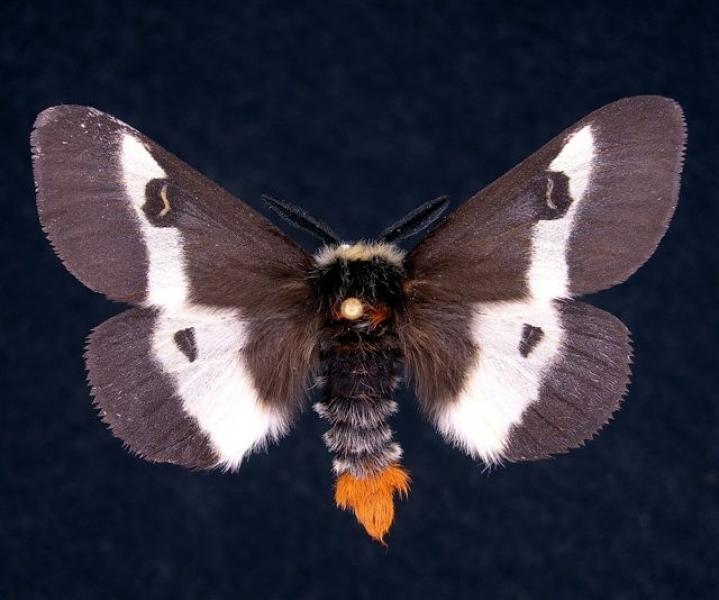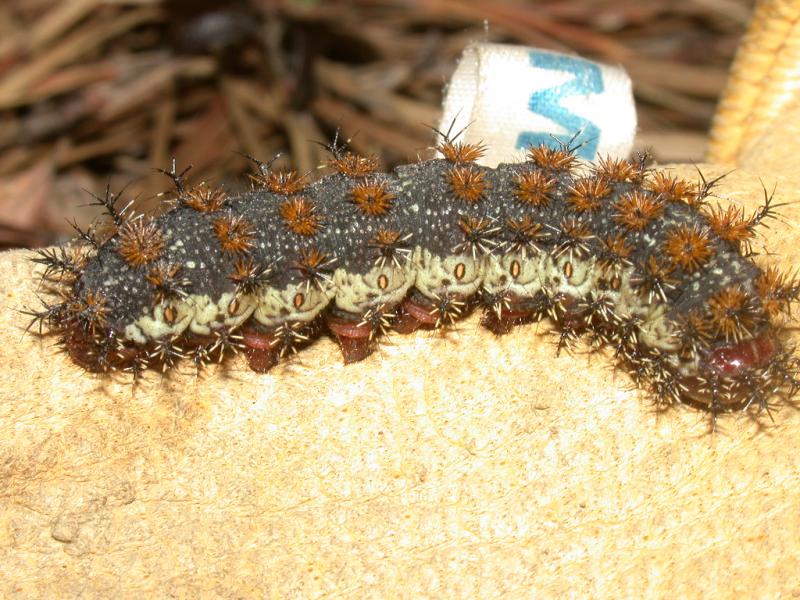Coastal Barrens Buckmoth
Hemileuca maia ssp. 5 None
- Class
- Insecta (Insects)
- Family
- Saturniidae (Giant Silkworm and Royal Moths)
- State Protection
- Special Concern
Listed as Special Concern by New York State: at risk of becoming Threatened; not listed as Endangered or Threatened, but concern exists for its continued welfare in New York; NYS DEC may promulgate regulations as to the taking, importation, transportation, or possession as it deems necessary.
- Federal Protection
- Not Listed
- State Conservation Status Rank
- S2
Imperiled in New York - Very vulnerable to disappearing from New York due to rarity or other factors; typically 6 to 20 populations or locations in New York, very few individuals, very restricted range, few remaining acres (or miles of stream), and/or steep declines.
- Global Conservation Status Rank
- G5T3
Vulnerable globally - The subspecies/variety is at moderate risk of extinction due to rarity or other factors; typically 80 or fewer populations or locations in the world, few individuals, restricted range, few remaining acres (or miles of stream), and/or recent and widespread declines. (The species as a whole is common globally.)
Summary
Did you know?
The name "buck moth" was given to this moth by American outdoorsmen who associated its flight season in October with deer hunting season (Cryan 1985).
State Ranking Justification
Within New York State, 18 populations of the Coastal Barrens Buckmoth are known to occur on Long Island. The subspecies is probably restricted to southeastern Massachusetts, Rhode Island, and Long Island, New York (NatureServe 2010).
Short-term Trends
The presence of the Coastal Barrens Buckmoth over multiple years at most of the 18 documented populations in New York State indicates that the population is stable, viable, and reproducing.
Long-term Trends
The long-term trend for the Coastal Barrens Buckmoth in New York State is unknown (New York State Department of Environmental Conservation 2005), but on Long Island four populations are known to have become extirpated due to habitat loss from development, indicating the moth has probably declined from historical numbers.
Conservation and Management
Threats
Threats include destruction of habitat due to development and fire suppression, which may become a problem after several decades (NatureServe 2010). Insecticide spraying might also be a threat. In addition, the Coastal Barrens Buckmoth was assessed to be moderately vulnerable to climate change, meaning that its abundance and/or range extent within its current geographical area in New York State is likely to decrease by 2050 as a result of climate change. Factors that may increase its vulnerability to climate change include its physiological thermal niche, physiological hydrological niche, physical habitat, and diet (Schlesinger et al. 2011).
Conservation Strategies and Management Practices
Maintaining habitat is the main management need. Periodic controlled burns or mechanical removal of vegetation are needed to maintain most of the natural communities that the Coastal Barrens Buckmoth inhabits. It is good practice to not burn entire habitats at once. Habitats should be burned in patches, always with some unburned areas left as refugia for species (Wagner et al. 2003). However, it is possible that the Coastal Barrens Buckmoth maintains a reserve of diapausing (dormant) pupae in the soil, enabling populations to survive fires (NatureServe 2010).
Research Needs
Additional inventory and monitoring is needed, particularly at the few unchecked potential sites, mostly scattered barrens remnants on Long Island. The Coastal Barrens Buckmoth flies during the day and can be captured by netting with butterfly nets. In addition, males can be attracted to bait from caged females, larvae can be easily observed on scrub oak (Quercus ilicifolia) and other shrubby vegetation, and eggs can be observed on twigs of scrub oak and other shrubby vegetation from the fall until the spring.
Habitat
Habitat
The Coastal Barrens Buckmoth is restricted to pitch pine-scrub oak barrens, including the Long Island Dwarf Pine Plains, on deep dry sands. It is also found on portions of the Nantucket heathlands with a lot of scrub oak. It is tolerant of either sparse canopy or no canopy (NatureServe 2010).
Associated Ecological Communities
- Dwarf pine plains
(guide)
A woodland community dominated by dwarf individuals of pitch pine and scrub oak that occurs on nearly level outwash sand and gravel plains in eastern Long Island. The soils are infertile, coarse textured sands that are excessively well-drained.
- Pitch pine-oak-heath woodland
(guide)
A pine barrens community that occurs on well-drained, infertile, sandy soils. The structure of this community is intermediate between a shrub-savanna and a woodland. Pitch pine and white oak are the most abundant trees.
- Pitch pine-scrub oak barrens
(guide)
A shrub-savanna community that occurs on well-drained, sandy soils that have developed on sand dunes, glacial till, and outwash plains.
Range
New York State Distribution
In New York State, the Coastal Barrens Buckmoth is restricted to Long Island (NatureServe 2010).
Global Distribution
The Coastal Barrens Buckmoth is probably restricted to southeastern Massachusetts, Rhode Island, and Long Island, New York (NatureServe 2010).
Best Places to See
- Dwarf Pine Plains County Nature Preserve (Suffolk County)
Identification Comments
Identifying Characteristics
Buckmoths of the species Hemileuca maia in general have a wingspan of 50-75 mm, and black forewings and hind wings, with white semi-translucent bands in the middle. The reniform spot on the forewing has a black border, and it touches the black basal patch. Males have a red-tipped abdomen, and females have a black-tipped abdomen (Covell 1984). The Coastal Barrens Buckmoth subspecies is distinguished by its small size, narrow habitat restriction, and especially by the extensive bright yellow pattern on late-instar larvae that includes a well-defined lateral band in almost all individuals on Long Island. Larvae are otherwise usually black and have branching spines along their back that can sting (Tuskes et al. 1996). The adults are somewhat thinly scaled (NatureServe 2010).
Behavior
Contrary to most moths that fly at night, Coastal Barrens Buckmoths fly during the day. On Long Island, they fly on sunny days in October. The moths emerge in the morning, with males emerging earlier than females. Mating usually takes place in the early afternoon, and females oviposit in the late afternoon. Females lay eggs in clustered rings, usually around twigs of scrub oak (Quercus ilicifolia), or sometimes other species of shrubby oaks. Females lay 1-3 egg ring clusters, with each cluster containing 50-250 eggs (Tuskes et al. 1996). The eggs overwinter and are coated with a waxy substance to prevent them from desiccating. In addition, the larvae inside are protected from the cold by a kind of natural antifreeze (Cryan 1985). The eggs hatch in the spring, and early-instar larvae feed together in groups in June and July. The small black larvae have many spines that inflict a painful sting when touched, which provides them protection from many predators but does not protect them from some parasites. By July, late-instar larvae scatter and become more solitary. At this stage, they may be found on plants other than oak. In late July or early August, larvae go a few cm below the soil surface, or between the soil surface and the leaf litter, where they transform into pupae and lie dormant until emerging as adult moths in the fall (Cryan 1985; Tuskes et al. 1996; Nelson 2007).
Diet
The larva of the Coastal Barrens Buckmoth is virtually restricted to scrub oak (Quercus ilicifolia) as its primary foodplant. A single report of oviposition on wild black cherry (Prunus serotina) is known. Like other subspecies of Hemileuca maia, larvae will readily eat most other oaks, willows, aspens, and P. serotina. In nature, older larvae do disperse and use willows, P. serotina, and other oaks occasionally if they encounter them. Young larvae eat new spring leaves, and older larvae eat mature leaves. Adult moths do not feed (NatureServe 2010).
Best Time to See
On Long Island, New York, Coastal Barrens Buckmoth larvae can be seen from May until July, and adults can be seen during their flight period in October. In addition, overwintering eggs are visible on vegetation from late fall until early spring.
- Reproducing
- Larvae present and active
- Eggs present outside adult
- Pupae or prepupae present
The time of year you would expect to find Coastal Barrens Buckmoth reproducing, larvae present and active, eggs present outside adult, and pupae or prepupae present in New York.
Similar Species
- Inland Barrens Buckmoth (Hemileuca maia maia)
(guide)
H. maia ssp. 5 is distinguished by the yellow pattern on late-instar larvae, and by its geographic range.
- Bogbean Buckmoth (Hemileuca maia menyanthevora)
(guide)
H. maia ssp. 5 is distinguished by the yellow pattern on late-instar larvae, and by its geographic range.
Coastal Barrens Buckmoth Images
Taxonomy
Coastal Barrens Buckmoth
Hemileuca maia ssp. 5 None
- Kingdom Animalia
- Phylum Arthropoda
(Mandibulates)
- Class Insecta
(Insects)
- Order Lepidoptera
(Butterflies, Skippers, and Moths)
- Family Saturniidae (Giant Silkworm and Royal Moths)
- Order Lepidoptera
(Butterflies, Skippers, and Moths)
- Class Insecta
(Insects)
- Phylum Arthropoda
(Mandibulates)
Comments on the Classification
The name Hemileuca maia subspecies 5 is used here for a cluster of distinctive populations on Long Island, New York, and the Cape Cod region, which differ from all other maia populations north of Florida by a combination of characters including larval coloration, adult appearance, and high restriction to open pine canopy sandy scrub oak barrens. The general literature recognizes only H. maia maia and H. maia peigleri, and the name H. maia maia is applied to the entire species outside of Texas. Here, the distinctive northern Coastal Barrens Buckmoth is also recognized as subspecies 5, and technically it probably is typical H. maia maia. Hemileuca maia maia is used for the rest of the entire eastern US oak-feeding buckmoth species, except for subspecies peigleri from central Texas.
Additional Resources
References
Covell, Charles V. 1984. A field guide to the moths of eastern North America. Houghton Mifflin Company, Boston.
Cryan, J.F. and R. Dirig. 1975. The moths of autumn. Unpublished article printed by Pine Bush Historical Preservation Project, Inc. 9 pp.
Cryan, John. 1985. Retreat in the barrens. Defenders. 60(1): 18-29.
NatureServe. 2010. NatureServe Explorer: An online encyclopedia of life [web application]. Version 7.1. NatureServe, Arlington, Virginia. Available http://www.natureserve.org/explorer. (Data last updated August 2010)
Nelson, M.W. 2007. Barrens Buckmoth (Hemileuca maia). Natural Heritage & Endangered Species Program Fact Sheet.
New York Natural Heritage Program. 2024. New York Natural Heritage Program Databases. Albany, NY.
New York State Department of Environmental Conservation. 2005. Comprehensive Wildlife Conservation Strategy Planning Database. New York State Department of Environmental Conservation. Albany, NY.
North American Moth Photographers Group at the Mississippi Entomological Museum. No date. Mississippi State University, Mississippi. http://mothphotographersgroup.msstate.edu/MainMenu.shtml
Opler, Paul A., Kelly Lotts, and Thomas Naberhaus, coordinators. 2010. Butterflies and Moths of North America. Bozeman, MT: Big Sky Institute. <http://www.butterfliesandmoths.org/> (accessed May 2010).
Schlesinger, M.D., J.D. Corser, K.A. Perkins, and E.L. White. 2011. Vulnerability of at-risk species to climate change in New York. New York Natural Heritage Program, Albany, NY.
Tuskes, P. M., J. P. Tuttle, and M. M. Collins. 1996. The Wild Silk Moths of North America: A Natural History of the Saturniidae of the United States and Canada. Cornell University Press, Ithaca, New York. 250 pp.
Wagner, David L., Nelson, Michael W., and Schweitzer, Dale F. 2003. Shrubland Lepidoptera of southern New England and southeastern New York: ecology, conservation, and management. Forest Ecology and Management 185: 95-112.
Links
About This Guide
This guide was authored by: Andrea Chaloux
Information for this guide was last updated on: January 23, 2012
Please cite this page as:
New York Natural Heritage Program. 2024.
Online Conservation Guide for
Hemileuca maia ssp. 5.
Available from: https://guides.nynhp.org/coastal-barrens-buckmoth/.
Accessed April 16, 2024.

